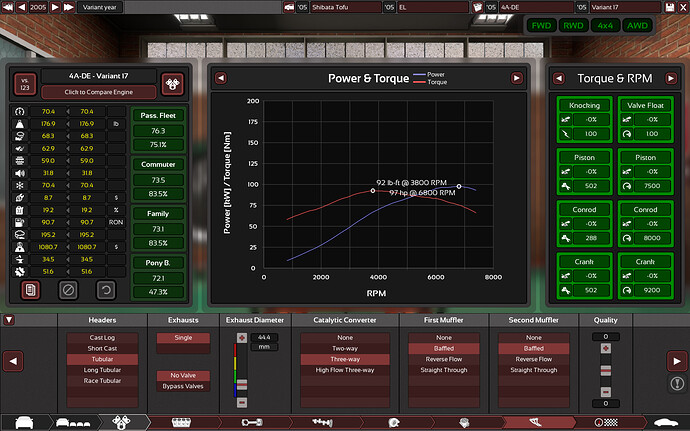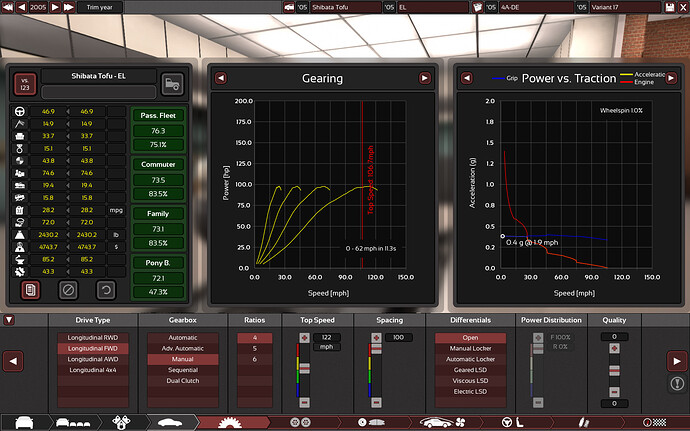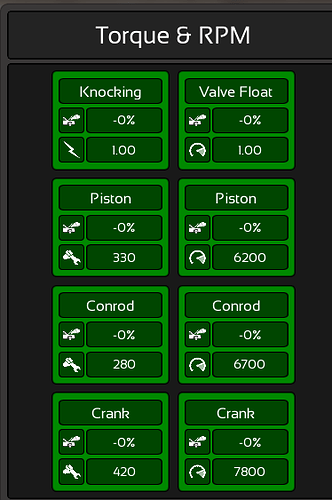I like it boxy. I’m not sure if I’m going to learn how to get 40 MPG if my primary “thing” is supercars. The base model has a 1.4L if I remember correctly, but it’s too early in the morning for me to check. Is that too big or what sorts of things do you change for fuel economy to improve?
The engine-building tutorials have all kinds of tips about how to improve the economy of the engine, but even that alone doesn’t guarantee good fuel economy test figures. Note that I said test figures, obviously real world economy depends on how you drive the car and the game has a very specific, uniform manner in which it calculates economy, so basically you will need to set the gearing such that it’s at its most efficient at the cruising speeds, which, given that car and the body, will likely necessitate an overdrive gear or two.
If you want specific information on how to maximise economy, maybe you can post more information. We like to see the parts you used, the gearing, the ventilation, and the engine power graph. In 2005, if MPFI is way better than SPFI, and DI is way better again but horrendous for the budget.
Alright, here’s the EL’s engine. Images are a little big.
It’s just naturally aspirated BTW. Obviously.
And the trim stuff:
I know you’re very smart, Strop. Good luck fixing this monstrosity.
No luck, really, a lot of people are familiar enough with the game to know how to optimise for a modern eco engine.
- Aluminium engines are rare because pure alu is actually harder to work with (too soft. Everybody uses AlSi these days unless you’re Rolls Royce)
- Nobody uses 3 valve by 2005. It’s reasonable to use 4 valve
- If you want to keep your top end output then use VVL and employ a VTEC like system. More expensive but worth it.
- Forged parts are for high revving engines. 7500rpm is high. Use cast and low friction especially for best eco results.
- Lacking VVT will probably also be affecting your economy at both ends (slightly). Set at least one cam profile to low, see where the percentage is highest. You may even get to the single digits.
- This will reduce your available compression, that’s fine, you don’t need a particularly high compression ratio.
- An eco engine doesn’t really need throttle per cylinder. It’s complex and just improves your throttle response but is expensive.
- For best results fuel mixture should always be as lean as possible
- Ignition timing is a bit of a hit and a miss but there’s always a point where it gives you a bit extra. Usually once you’ve nailed down all the other stuff I’d work on optimising the balance between compression and ignition.
- Also, for an eco eco engine nobody is going to crucify you for not having an optimal power band, which you’ll rapidly find is difficult to achieve in a low friction cast engine anyway.
- You don’t need a tubular exhaust system for anything less than about 200bhp. Short cast will be fine. And it’s too large. Flip over to the flowbench (right panel) and adjust the exhaust diameter until the exhaust flow drops below 1, and that’ll be better.
- It’s rare for a 2005 car to have a 4 speed manual. That will make things very difficult, so use a 5 speed and don’t be afraid to overdrive one gear so that at least at 100km/h you’re not doing 5000rpm, because that’s horrendous on the economy.
- While I’m at it your brakes could do with a bit of balancing. Eco cars will have brake fade, but it’s more that your rear wheels will lock all over the place and the fronts don’t have enough force on them. No idea how you plan to fix that tbh, but 39m stopping distance is pretty long!
My engine will likely be a bit more expensive than yours, in which case you can happily drop VVT without any significant problems. But it also has 30% efficiency which is insane for a 2005 engine, and will definitely help you hit that 40mpg easy.
I just realised I can’t export files, so here’s what you need:



If you want more power… make the engine larger  Rightsizing, not downsizing is key!
Rightsizing, not downsizing is key!
You have hit the nail on the head - I would have done something similar. Another benefit of an all-AlSi engine is that the absence of cylinder liners leads to reduced weight and engineering time. But would a six-speed manual have been worthwhile for this application? If not, it would most likely seem like overkill. And a standard intake would be sufficient for an engine focused mainly on economy, where the extra airflow from a performance or race intake is not needed.
On occasion, your posts approach making decent sense. At other times, I still wonder what you’re looking at:
No duh. That being said 6 speed manual in 2005 would have still be considered the domain of higher end sporty cars. An eco box would be making do with a 5 speed. Then again an eco box probably wouldn’t have DI in 2005.
Nobody put a performance or race intake on the eco trim???
Can you at least explain what the fuck an “overdrive gear” is?
I additionally have no idea how to balance brakes. I’ve been winging it the whole time.
Also, I’ve been using forged internals because its material cost is the lowest.
I’m still adapting the engine to your advice, but here’s something I’ve found.
With cast iron conrods and low friction cast pistons:

…and with steel conrods and forged pistons…
![]()
Hmmmm. And it’s not the conrods. Changing conrods does not affect the economy. This might just be for the half-finished set-up I’m using.
EDIT AGAIN: Finished the setup, and it’s knocking. It knocks worse with low friction cast.
Can you at least be polite to the people who are helping you.
This image will explain what an overdrive gear is.

The total cost of a car go beyond raw material costs. There’s engineering time - how long it takes to draw up the technical knowledge to build the car to certain specifications, and there’s production units - how much time does it take to manufacture each individual component which in turn adds up to the grand total of the car. Of course people need to be paid to do these jobs so the higher they are the more the car will cost again. And rather than just eyeing material cost, observe what function different systems have and the different advantages of different choices. For example: low friction cast will give you very good fuel efficiency but don’t rev very high. Forged pistons can rev high, are suitable for high power output purposes, but aren’t very fuel efficient and emit a lot. Hypereutectic cast will rev as much as basic cast pistons but offer greatly lower emissions levels, etc. You may need to invest in using components that cost more to make products that serve customers better even if it means higher cost - again, there’s more to value than outright cost. Being able to do it’s task well also counts towards being good value.
I give up.
No. No you won’t. That is an order. The only way you can perfect your designs is that you fail, then see what’s wrong and fix it. If you give up now, you won’t learn anything new. Getting something to work just right is damn hard, but when you get it right you’ll be so happy that you did something gud, and the people here might even give you some recognition for it.
So go now and make that design work damn well and I’ll give you a cookie!
Show us what you’ve got!
Knocking is the easiest thing to fix in an engine. Of course the engine behaves differently when you change the components. You are expected to be able to at least read the screen which does the work of diagnosing your issues for you, and then address it!
I gave you advice on the presumption that you knew the basics of how the internal combustion engine worked, but I could have been wrong. If you didn’t understand what everything does the first time, listen to the tutorials again (I assume they are still around, sorry if they’re not). Also at least go through some of the easy engine scenarios because they actually teach you the mechanics of how the game works.
No. No you won’t.
Yes. Yes I will.
Never before I’ve been so disappointed in someone.
I have every reason to consider this an act of cowardice. What’s the point of buying the game if you can’t learn how to get the most out of it?
If you really cannot (or don’t want to) learn how to build a competitive car, don’t bother with the game at all. In fact, you are making yourself feel like you should never have bought the game in the first place, but that would create a new set of problems by itself.
Or you could export your cars and share them on the open source thread, just so that other users will be able to improve them. Obviously, this won’t be possible until the ability export cars and engines is added to the UE4 release, but for that reason alone, it might be worth waiting for.
I’m finally making something I’m good at making for once.
(This is a teaser, BTW. Totally not another Dastardly.)
1995 Shibata Tsunami
Shibata’s take on the Dastardly.
Sorted from least to most expensive
Base - $12,000
147 hp
126 lb-ft
0-60 in 8.6 seconds
Top speed of 121 mph
60-0 in 32 m
28 mpg (Same as the base Tofu?)
Base Turbo - $12,720
188 hp
159 lb-ft
0-60 in 8.5 seconds
Top speed of 136 mph
60-0 in 31 m
24 mpg
HPX - $20,800
299 hp
240 lb-ft
0-60 in 4.6 seconds
Top speed of 151 mph
60-0 in 29 m
15 mpg!?!?
Race - $???
424 hp
300 lb-ft
0-60 in 4.3 seconds
Top speed of 164 mph
60-0 in 29 m
12 mpg
Next up - I don’t know.
Why is the base turbo only .1 seconds faster to 60 than the base version despite having 40 more horsepower? Does it have poor gearing for achieving 0-60?
I don’t know. It’s probably tuned too far to top speed.
Maybe the turbo system adds weight.




















